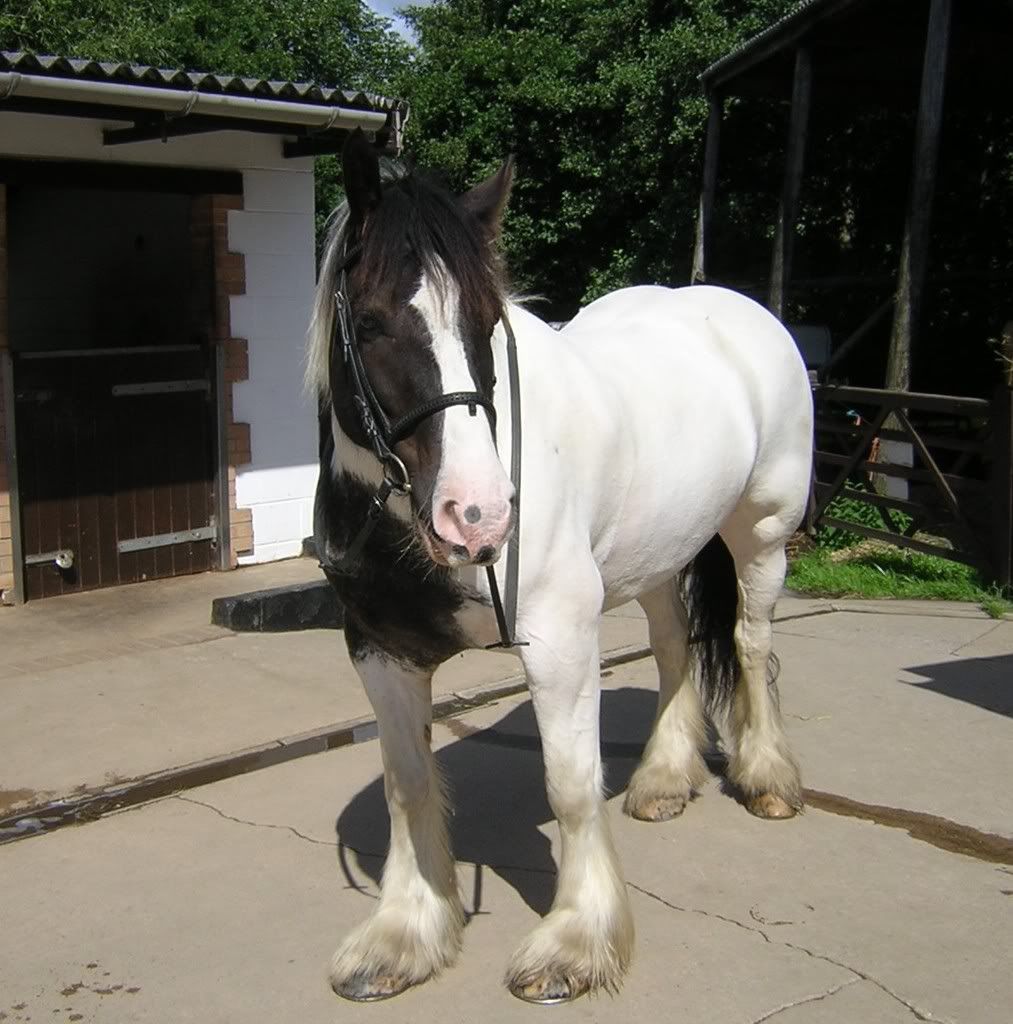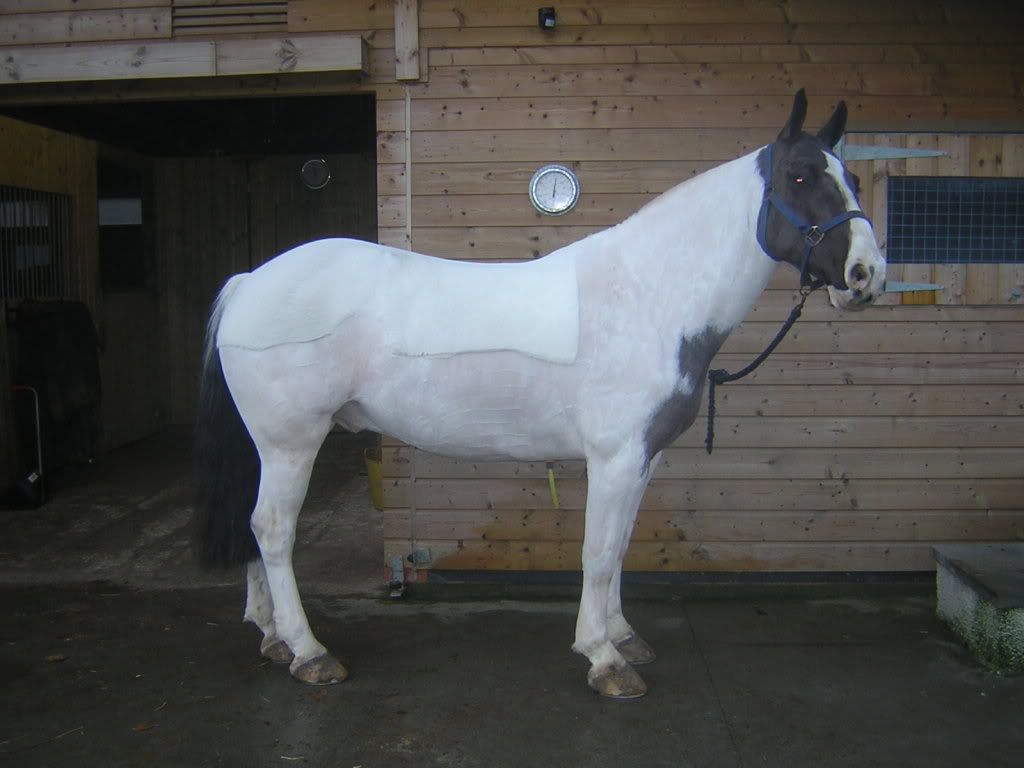zoon
Apprentice Poo Picker
 
Posts: 482
|
Post by zoon on Feb 3, 2009 18:17:03 GMT
Ok, well Tex is fat. It had to be said. Not grossly obese, but definately fat - I can't feel his ribs without really poking him. Not his owners fault - he is a good doer that has done very little exercise for a long time.
But I've absolutely no experience of good doers (except my ponies as a kid, but I didn't have to worry about what they were fed and their weight as my grandad did all that) As most of you know I struggle to keep weight on Zoon.
He was out during the day and in at night with about 3 sections of hay - he's not at all greedy and eats quite slowly. He's been in since I've had him due to masses of snow so he's had hay and I've also added in a tiny feed of a small handful of redigrass that I can mix his vitamin and mineral supplement with as the grass is very poor down here.
Today I went and bought some small holed hay nets to make his hay last longer so he has less over the day, but what else can I do?
Obviously the weight will start to come off with exercise, but any other tips for the wobbly horse?
|
|
|
|
Post by fimacg on Feb 3, 2009 18:35:54 GMT
see the thread about the Lo-cal feed - all mine get are hay overnight out in fields with very little grass during the day, and one feed on a lo-cal balancer to make sure they get all their vitamins and minerals and a handful of chaff, and they could still do with loosing weight. Chompy especially would get fat if he was left on a pavement and the only way to keep him trim is exercise. and I hope you don't think I'm hijacking your thread but this is the day I went to view Chomps, Was told by the vet he was grossly obese and had to loose 100kg  2 years later we have lost 80kg and he looks like this  so there is hope for the dieting horses. |
|
jane
Novice Willy Washer
  
Posts: 954
|
Post by jane on Feb 3, 2009 19:16:18 GMT
I agree with Fi - lo-cal balancer and a bit of hay.
Wow chompy was a tubby boy - hehe - what a big bottom he had....
But what a sleek and handsome chap he is now
jane
|
|
|
|
Post by racaille on Feb 4, 2009 8:34:40 GMT
Blimey Chomps was a chubby!!!
I'm not a huge fan of 'diet' feed for animals (especially not dogs, but that's another thread...) I think it's simply a question of exercise, lots of fibre plus vits and mins if you need to.
|
|
joandlad
Apprentice Poo Picker
  My beautiful boy!
My beautiful boy!
Posts: 473 
|
Post by joandlad on Feb 4, 2009 10:36:53 GMT
I've got a good-doer and it's taken me ages to get weight off him but we've got there at last. ;D It was hard for us as he is only 4 so I can't work him as hard as I'd want in order to lose the weight so we've had to do it mostly through diet (but not diet as in feeding less).
Now is the time to really get it sorted as Spring is just round the corner and it is virtulally impossible to shift weight then (unless you keep them in 24/7). I use well soaked hay for Murph. I put it in to soak in the morning and take it out and feed in the evening so it gets about 9 hours of soaking. He is obsessed by food and can demolish a section of hay in 5 mins so soaking it for so long means I can give him 6 sections a night but he gets very little calories from it. It's mostly just a way of making sure they are still getting the fibre passing through them constantly. Like you I feed a vit/min supplement (balancer) but use a tiny bit of unmolassed sugar beet and lucie stalks (low calorie, unmolassed alfalfa) to carry it. Murph has a trace clip and only wears a lightweight rug outside, nothing in the stable. They use loads of energy keeping warm so it's a good way to burn off some calories. He always feels warm so he definitely doesn't need any extra layers. He wears a muzzle in the Spring/Summer. It's pretty amazing how much they can actually get through the hole once they get used to it. He doesn't seem to care one bit about wearing it. I had to try a few different ones til I found one that fitted him without rubbing. I'm hoping that this year, as he is in work, he won't have to wear the muzzle as often.
World Horse Welfare are running a big Right Weight Campaign at the moment. Here is some info from them on losing weight:
It can be hard to tell whether your horse has a weight problem. The likelihood is that - unless you feel pretty certain he hasn’t - he could well do!
Leisure horses are at particular risk of being overweight as their workload isn’t great and they are treated with loving kindness by their owners. But overfeeding and underworking a horse are not the signs of a caring owner.
If you are not sure about your own horse’s weight then see the Bodyfat scoring download and watch the Fat-scoring video, both from World Horse Welfare. These will help you to have a very good idea of the situation. You could also ask your vet but, generally, friends and other horse owners may not be a good judge of the situation, so don’t rely on what others say.
Once you have made your assessment you then need to take action. If your horse appears to be an ideal weight then remember to monitor his condition regularly with a weigh tape, so catch any changes early.
If your horse is overweight then following the advice outlined here will help a great deal.
Get the weight off your horse
Late winter/early spring is the ideal time to get and keep the weight off your horse – before the spring grass kicks in (listen to the Weight-loss podcast for more on this)
Take rugs off your horse earlier than usual, as he will use fat to keep himself warm. Unclipped natives with shelter shouldn’t need rugging at all – and if you are used to rugging your horse up very warmly, try using a lighter-weight version of the rug you would normally use.
Section your field off for strip-grazing or invest in a grazing muzzle, and use these before the spring grass arrives. Remember it is better for your horse to be carrying less condition as he goes into spring, as he is designed to put weight on as the grass grows.
Put more animals in the same field to share the grass between more mouths. Maintain the grazing correctly, picking up droppings and so on.
Mow your grazing to mimic having more animals in the same area. Make sure no cuttings are left in the field.
Start an exercise regime. If your horse is very overweight you will need to take it slowly. The best form of exercise for weight loss is actually regular brisk walking – so try to build this into your daily routine.
Remember never, ever to put your horse on a starvation diet. He is a trickle feeding and needs regular food going through his system to avoid complications such as colic. Speak to a feedline for advice on your individual situation.
Soak your hay for 12 hours to remove the calories so you can feed your horse lots of bulk without adding to any weight problems. Use fresh water each time.
You can also feed oat or barley straw as an alternative to soaked hay or to dilute unsoaked hay. Check your horse’s droppings to make sure the straw fibres are no more than 2 mm long. If they are, straw is not suitable for your horse and you could risk colic.
If you feed straw or soaked hay, you must feed a general vitamin and mineral supplement as well. You could also use a small-holed haynet to help slow down your horse’s eating.
Assess his diet
If you are giving your horse a small feed simply to carry a supplement, it could be enough to stop him losing excess weight. Can you feed the supplement in a way that provides fewer calories?
If you use a concentrate feed, speak to the manufacturer to find out whether you are doing light, medium or hard work – their definitions may be different to yours.
Weigh your feed
You may be surprised how much extra you are feeding. Find a container that fits exactly the amount you should be giving and no more. It is very easy for half a scoop to turn into three-quarters or more.
Do you really need that rug?
It’s very easy for us to rug our horses because we wouldn’t like to be out in the winter without a coat, but remember that horses already have waterproof coats and their own central heating systems. Digesting fibre generates a lot of heat, which helps keep the horse warm from the inside out. Some horses will need to wear a rug but if your horse is overweight consider whether he could go without or if a lighter weight rug would be more suitable.
Keep monitoring your horse
Fat-score and use a weightape on your horse every two weeks. You will notice any changes in weight far more quickly than you could by eye. Make sure you use the tape at the same time of day, as horses’ weight fluctuates significantly over a 24-hour period.
Keep an eye on how your horse is affected by any changes you make. What is suitable at one stage may not be suitable a few weeks down the line.
Remember, if your horse’s weight changes significantly at any point, his tack may no longer fit. Poorly fitting tack can lead to a variety of problems, so get this checked by an expert.
Finally, always give your horse time to adjust to any changes you make.
Advice courtesy of World Horse Welfare
If you need any further advice, speak to experts such as your vet, farrier and saddler. Most feed companies have helplines where you can speak to a qualified nutritionist. You can also call the World Horse Welfare Advice Line on 01953 497238.
|
|
|
|
Post by brigadier on Feb 9, 2009 22:05:10 GMT
I love Chomps loveheart bum in the first pic!
|
|
|
|
Post by fimacg on Mar 11, 2009 12:23:04 GMT
bumped for neighlass
|
|